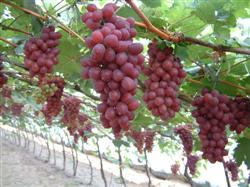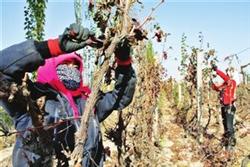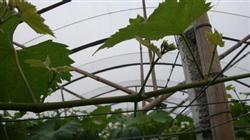Light Control Technology of Grape cultivation in greenhouse

For grapes cultivated in greenhouse, because the light intensity in the greenhouse is often less than 70% of that outside, it has a significant adverse effect on the growth and fruit of grapes, often resulting in serious flower and fruit drop, poor fruit coloring, low sugar content, poor flower bud differentiation and so on. The yield and quality of grapes are greatly reduced. Therefore, to enhance the light intensity in the greenhouse has become one of the key technologies of grape protected cultivation. 1. Greenhouse design requirements 1. Location. look south. In order to make better use of the morning light, the orientation can be 5-10 degrees west in areas with severe cold and foggy mornings, and 5-10 degrees east in areas where it is not too cold and foggy in winter mornings. two。 Reasonable design of the front roof angle. The actual measurement shows that in the north of China, the incident angle has little effect on the light transmittance within 40-90 degrees. Therefore, in the actual construction of the greenhouse, the angle between the greenhouse surface and the level can be changed to 2325 degrees, which can not only significantly reduce the slope of the greenhouse surface, conducive to management, but also greatly reduce the construction cost of the greenhouse. When a greenhouse is built in the area north of 40 degrees north latitude, the front roof angle of the greenhouse will be increased by 1 / 2 degrees for each increase in latitude. For example, the roof angle in front of the greenhouse in Beijing, Tianjin and Tang should be 21-24 degrees, so that the sunlight transmittance is most suitable for grape growth. The angle of the auxiliary light receiving surface should be 60-70 degrees, which can absorb scattered light and increase the light intensity in the greenhouse. Second, choose the plastic film with good light transmittance and keep the film surface clean, the plastic film has a good performance of transmitting ultraviolet light, and the blue drip-free film has the best light transmission performance, which is widely used in production. Glass is not as good as plastic film in transmitting ultraviolet rays, so it is not suitable to be used. The selection of plastic film mainly considers its durability, light transmittance, heat preservation and non-dripping. If there are water droplets on the surface of the plastic film, the light transmittance will be reduced by 28% to 30%, so it is necessary to choose a drip-free plastic film. The multi-layer composite heat preservation and high light transmittance greenhouse film EVA is still intact after 18 months of use, with a drip-free duration of 6-8 months, 2 ℃-3 ℃ higher in daytime, 1-1.5 ℃ higher at night, and 70% light transmittance after 18 months. Always remove the dust from the film surface and keep the greenhouse film clean. Third, lay a silver-gray reflective film on the north, east and west walls or the ground of the greenhouse, so that the sunlight shining on the film is reflected to the grape plant and increase the amount of light received by the grape leaves. Laying reflective film on the ground can increase the light intensity by 25%, and increase the temperature by 1 ℃ at 1 meter under the greenhouse. A reflective film of 200 square meters per mu of greenhouse is laid at a cost of 150,200 yuan, which can be used continuously for 3 years. This measure is one of the most economical and effective ways to enhance light, especially for the improvement of color and quality of non-ferrous varieties. Before laying the film, the old leaves should be picked for the first time to level the land. After the film is laid, the plastic bag filled with sand and gravel should be compacted to prevent it from being picked up or scratched by the wind. Fourth, the installation of biological sodium lamp, supplementary lighting biological sodium lamp can balance the spectral distribution, has a high light output, has a good light supplement effect. The experiment shows that in cloudy days, adjusting the biological sodium lamp to red and yellow spectrum in the greenhouse is most beneficial to the growth and fruit quality of grape. Fifth, whitening the walls and columns of the greenhouse with lime can enhance the reflection of light, significantly improve the lighting conditions in the greenhouse, and increase light, temperature and photosynthetic efficiency to a certain extent. 6. After spraying photosynthetic accelerant on grape leaves, spraying photosynthetic accelerant for 4 times can obviously promote leaf photosynthesis.
- Prev

Grape varieties and pollution-free cultivation techniques
The period of winter pruning of grapes is generally from the first ten days of November to the middle of February of the following year, that is, from 2-3 weeks after defoliation to 3-4 weeks before the occurrence of spring injury. Pruning too early will affect the return of nutrients, too late will easily lead to bleeding phenomenon. Bleeding often affects the germination of bud eyes, growth and fruit. Now it is mainly.
- Next

Key Technical points of Grape Spring Management
Spring is the season for grape sprouting, leaf spreading, branch elongation, heading, flowering and fruiting. Strengthening the management of grape in spring can improve the yield and quality of grape. From the middle and last ten days of February to the beginning of March, the budding water was irrigated and available nitrogen fertilizer was applied. Orchards with conditions at this stage should be irrigated in time to ensure neat sprouting. And at this point.
Related
- Moge, come on! The staff of the peasant association in the producing area of cantaloupe were frightened when the crowd gathered.
- Causes and Solutions of low Fruit setting rate of Apple
- Symptoms and control measures of passion fruit virus disease
- Fruit growing lesson: how do apple orchards keep high yields?
- Can you build orchards in the mountains? What are the pros and cons?
- How to manage the coloring period of Crisson grape?
- This paper introduces the processing technology of two kinds of fig products.
- How much is a month for retired teachers in rural areas by 2020?
- How can strawberry planting increase sugar content? We should pay attention to management in many aspects.
- What are the cultivation techniques on how to improve the yield of golden fruit?

